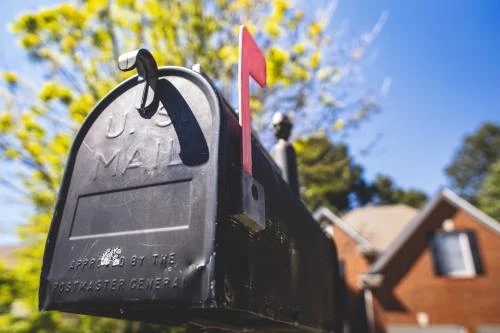
5 minute read
Stopping Mail Delivery After Death - What You Need to Know
What you need to know about what happens to mail when someone passes away and how to stop mail delivery.

Craig Parker, @CraigParker
Assistant General Counsel, Trust & Will
Did you know that the United States Postal Service delivers 425 million pieces of mail per day, and to 160 million delivery addresses? To say that USPS is a well-oiled machine is an understatement. Whether it’s rain or shine, the mail never fails to come. However, this also means that mail will continue to be delivered to someone who has passed away. A loved one will have to contact the Postal Service and request that the delivery of mail be stopped, but unfortunately, it’s not as simple as making a phone call. So, how does one stop mail delivery? Trust & Will reveals everything you need to know on how to stop mail for a deceased person.
What Happens to Mail When a Person Dies?
When someone passes away, their mail will continue to be delivered to their last address on record. It will continue to be delivered indefinitely, until an authorized person puts in an official request to the United States Postal Service (USPS) to stop mail delivery.
Receiving mail for a deceased person may be necessary and important for a certain period of time. For instance, as the family member or the Executor, you may need the deceased person’s mail to settle certain financial or business matters, and to help settle the estate. After all outstanding matters are settled, however, the continued delivery of mail can prove to not only be unnecessary but a constant painful reminder of your loss.
Although there are no estate planning rules or laws requiring you to stop mail for a deceased person, there will naturally come a time when you want to reduce and/or eliminate mail addressed to them. The next section will go over the steps to follow to stop mail for a deceased person.
How to Stop Mail for a Deceased Person
So, how do you stop mail delivery for a loved one who has passed away? Although it’s not as simple as making a phone call to your local post office, you’ll find that the process is relatively simple as long as you know what to do and follow the steps correctly.
Before you begin, note that mail should be stopped by the Executor of the deceased person’s estate. The Executor is the person who has been appointed by the probate court to manage the closing of the decedent’s estate, which includes the closing of their personal affairs. This could include notifying the Social Security Administration, credit bureaus, and Postal Service of the death, amongst other activities.
If you are receiving the deceased person’s mail to your address but are not the Executor, then you should forward the mail to their address. This is because they are legally authorized to open, read, and stop mail on the behalf of the deceased person.
Send a Court Order to the Post Office
The first step is to notify the Post Office of the death. Once the estate has finished going through the probate process and is officially closed, you can either mail or hand-deliver a copy of the probate order to the deceased person’s local post office.
The court order states that the estate is closed and dismisses you from your Executor role and duties. Therefore, you should no longer have any business that would require you to open and read the deceased person’s mail.
Along with the copy of the probate order, you should include a letter requesting that any and all mail services be stopped immediately. Unfortunately, there is no way to make exceptions for certain types of mail, so you should wait until you are ready to discontinue mail delivery in its entirety.
Register the deceased person on the Deceased Do Not Contact (DDNC) List
Along with requesting to stop mail delivery via the Postal Service, you can also submit a request to stop receiving mail, phone calls, and emails from certain marketers.
The DMA Choice is a non-profit organization that administers the Deceased Do Not Contact list (DDNC). Now part of the Association of National Advertisers, the DMA manages a membership of direct marketing agencies. By registering through the DMA’s DDNC list, you can reduce unwanted marketing messaging from advertisers.
To enroll, enter the deceased person’s contact information on https://www.ims-dm.com/cgi/ddnc.php. Once registered, the deceased person is included in a national Do Not Contact list. Members belonging to DMA will remove this person from their direct marketing lists.
Note that many marketers do not belong to the DMA, so this step will not necessarily eliminate all marketing efforts. However, you should notice a significant reduction over time.
Forward all mail to a different address
Another option is to forward all of the deceased person’s mail to a different address than your own. For instance, maybe you are the estate Executor and want to make sure that the deceased person’s surviving spouse receives the mail moving forward.
Although it is the polite thing to obtain permission first, you can work with USPS to forward all of the deceased person’s mail to a new address.
This is a relatively simple process. Simply file a request with your local USPS office by filling out a forwarding change of address order. Be ready with proof that you are authorized to manage the deceased person’s mail. This could be a copy of the court order stating that you are the appointed Executor or Administrator of the estate.
Note that the USPS mail forwarding service only lasts for one year. You may need to complete a new forwarding order, or follow the instructions from earlier to stop the mail entirely.
Cancel subscriptions
There are certain pieces of recurring mail that can be stopped effectively by going directly to the source. Did your loved one subscribe to any newspaper or magazine? A local farm box? Perhaps a clothing subscription service?
These are all examples of subscriptions that can be canceled by contacting the company or organization directly. Further, these subscriptions may have associated charges that should be promptly terminated as well, so that chargers do not continue appearing on the deceased person’s credit card or bank account.
Utilize “return to sender”
Last but not least, keep in mind that these systems are not perfect. It may take time for your requests to be processed. Further, pieces of mail may continue trickling in for a period of time.
An easy trick is to make use of the “Return to Sender” function of the post office. Simply write “Deceased, Return to Sender” on any piece of mail that is addressed to the deceased person. Put it in your mailbox (or other outbound box), and your mail carrier will collect it the following business day.
If you happen to know where the piece of mail should be forwarded and know the address, you can easily forward the mail. Cross out your address and then write down the forwarding address in block letters. Last, write “Forward” on the envelope. Put it in your mailbox and the mail carrier will pick it up and process it for forwarding.
Have More Questions? Review Our Complete Checklist of What to Do When Someone Dies
Receiving unwanted mail can be a frustrating thing. If you are mourning the death of a loved one, then receiving their mail can be painful. However, don’t forget that it is a federal offense to open and read someone else’s mail. The only exception is if you are that person’s legal representative.
Appointing an Executor and/or Power of Attorney is the surefire method of authorizing someone you trust to deal with your mail if you pass away or become incapacitated. You can do so by setting up your Estate Plan. Trust & Will offers affordable and accessible products that make it easy to set up a Will and/or Trust. Even better, you can do it all online from the comfort of your home!
We also provide plenty of education surrounding estate planning, to make the entire process easier for you and your loved ones. For instance, stopping mail delivery is just one of many arrangements that need to take place following someone’s passing. We provide a step-by-step process on what to do when someone dies. Our goal is to provide processes and guides to make any estate planning and related process as painless and empowering as possible so that you can focus on what’s truly important.
At Trust & Will, we’re here to help you keep things simple. You can create a fully customizable, state-specific Estate Plan online in just 20 minutes. Take our free quiz to see where you should get started, or compare our different estate planning options. Get started today!
Is there a question here we didn’t answer? Browse more topics in our Learn Center or chat with a live member support representative!
Trust & Will is an online service providing legal forms and information. We are not a law firm and we do not provide legal advice.
Recommended for you

End of Life Planning —5 min read
Writing My Will at 34: What They Don't Tell You About End-of-Life Planning Without Kids or a Spouse

End of Life Planning —9 min read
Little Miss Sunshine: Unexpected Death Planning

End of Life Planning —5 min read
Top 10 Songs Millennials Want Played at Their Funerals
Create your estate plan today.
Get Started